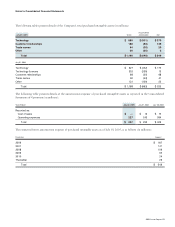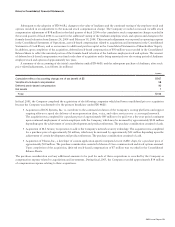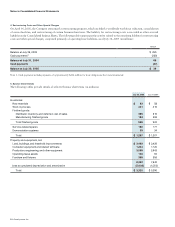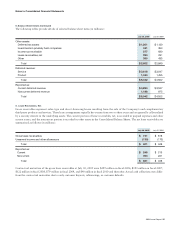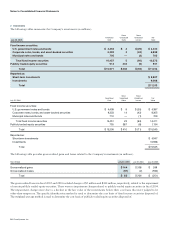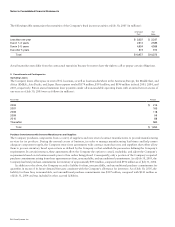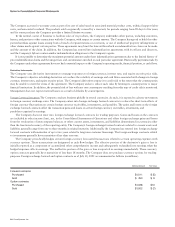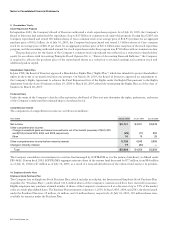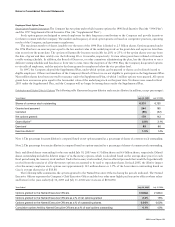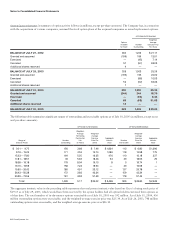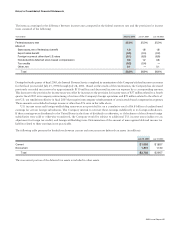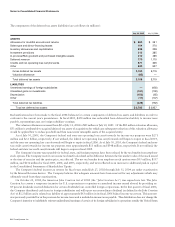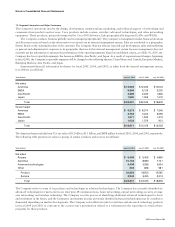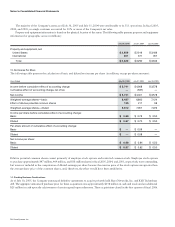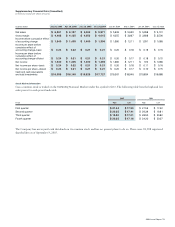Cisco 2005 Annual Report Download - page 58
Download and view the complete annual report
Please find page 58 of the 2005 Cisco annual report below. You can navigate through the pages in the report by either clicking on the pages listed below, or by using the keyword search tool below to find specific information within the annual report.
61
Interest Rate Derivatives The Company’s primary objective for holding fixed income and debt securities is to improve its investment return
while preserving principal and managing risk. To realize these objectives, the Company may utilize interest rate swaps or other
derivatives designated as fair value or cash flow hedges. As of July 30, 2005, the Company had entered into $1 billion of interest rate
swaps designated as fair value hedges. Under the interest rate swap contracts, the Company makes fixed-rate interest payments and
receives interest payments based on the London InterBank Offered Rate (LIBOR). The effect of these swaps is to convert fixed-rate
returns to LIBOR-based returns on a portion of the Company’s fixed income portfolio. The gains and losses related to changes in the
value of the interest rate swaps are included in other income (loss), net, in the Consolidated Statements of Operations and offset the
changes in fair value of the underlying hedged investment. As of July 30, 2005, the fair value of the interest rate swaps was $15 million.
There were no interest rate derivatives as of July 31, 2004.
Equity Derivatives The Company maintains a portfolio of publicly traded equity securities which are subject to price risk. The Company
may hold equity securities for strategic purposes or to provide diversification for the Company’s overall investment portfolio. In order
to manage its exposure to changes in the value of certain equity securities, the Company may, from time to time, enter into equity
derivative contracts. As of July 30, 2005, the Company had entered into forward sale and option agreements on certain publicly
traded equity securities designated as fair value hedges. The gains and losses due to changes in the value of the hedging instruments
are included in other income (loss), net, in the Consolidated Statements of Operations and offset the change in the fair value of the
underlying hedged investment. As of July 30, 2005 the notional and fair value amounts of the derivatives were $198 million and
$19 million, respectively. There were no equity derivatives as of July 31, 2004.
Legal Proceedings
Beginning on April 20, 2001, a number of purported shareholder class action lawsuits were filed in the United States District Court for
the Northern District of California against the Company and certain of its officers and directors. The lawsuits have been consolidated,
and the consolidated action is purportedly brought on behalf of those who purchased the Company’s publicly traded securities between
August 10, 1999 and February 6, 2001. Plaintiffs allege that defendants have made false and misleading statements, purport to assert
claims for violations of the federal securities laws, and seek unspecified compensatory damages and other relief. The Company believes
the claims are without merit and intends to defend the actions vigorously. While the Company believes there is no legal basis for liability,
due to the uncertainty surrounding the litigation process, the Company is unable to reasonably estimate a range of loss, if any, at this time.
Beginning on April 23, 2001, a number of purported shareholder derivative lawsuits were filed in the Superior Court of California,
County of Santa Clara, in the Superior Court of California, County of San Mateo and in the United States District Court for the Northern
District of California. These actions were later consolidated. The complaints included claims for breach of fiduciary duty, waste of
corporate assets, mismanagement, unjust enrichment, and violations of the California Corporations Code; sought compensatory
damages, disgorgement, and other relief; and were based on essentially the same allegations as the class actions. On March 22, 2005,
the Superior Court approved a comprehensive settlement of all of these derivative claims, which provided for dismissal with prejudice
of all of plaintiffs’ claims, reimbursement of a portion of plaintiffs’ attorneys’ fees and agreement to maintain certain Company
policies and consider others.
On February 16, 2005, a purported shareholder derivative lawsuit was filed in the Superior Court of California, County of Santa
Clara, against various officers and directors of the Company and naming the Company as a nominal defendant. The lawsuit includes
claims for breach of fiduciary duty, unjust enrichment, constructive trust and violations of the California Corporations Code, is based
upon allegations of wrongdoing in connection with option grants and compensation to officers and directors, the timing of option grants,
and the Company’s share repurchase plan, and seeks unspecified compensation and other damages, rescission of options and other relief.
In addition, the Company was subject to patent claims asserted by Storage Technology Corporation against the Company on
December 10, 1999. Claims related to one patent were dismissed, and a trial relating to claims related to a second patent commenced
May 19, 2005 in the Federal District Court for the Northern District of California. The claims which were the subject of the trial
included an assertion that NetFlow Feature Acceleration infringed United States Patent No. 5,842,040, and included demands for
damages and injunctive relief. On June 7, 2005, the court entered judgment in the Company’s favor when the jury returned a verdict
finding no infringement by the Company and that the patent claims at issue in the case were invalid.
In addition, the Company is subject to legal proceedings, claims, and litigation arising in the ordinary course of business,
including intellectual property litigation. While the outcome of these matters is currently not determinable, the Company does not
expect that the ultimate costs to resolve these matters will have a material adverse effect on the Company’s consolidated financial
position, results of operations, or cash flows.
Notes to Consolidated Financial Statements


